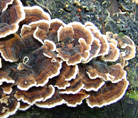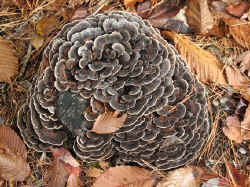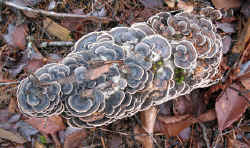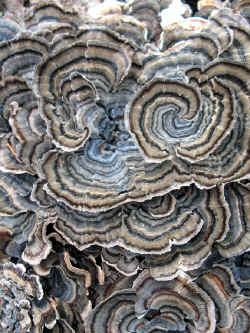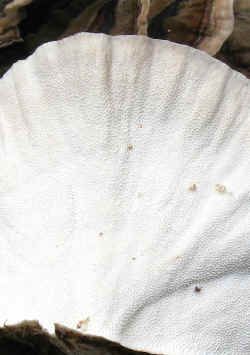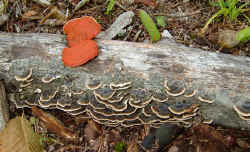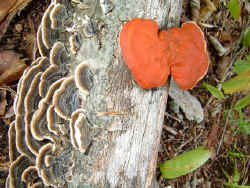|
|
A New England and Eastern Canada Edible and Medicinal Mushroom Resource |
||||||
|
Turkey tails are possibly the most common mushroom you will find. They are saprobic growing everywhere on dead or rotting stumps and branches. As "versicolor" may suggest, they are very variable in color. Their uses are mainly medicinal and decorative. They can have great beauty. They dry easily to become leathery tough. I have seen them used by artists in various assemblages and even as jewelry. They also can be used to make blue and green dyes for wool and other fabrics. There has been quite a bit of research done on these for their medicinal value as adjunct cancer treatment including colorectal cancer and leukemia. A protein-bound polysaccharide called PSK (Krestin) has been developed in Japan for cancer therapy. Cap (pileus) 1/2 - 4 inches, flat or wavy overlapping leathery, thin, caps. Hairy with zones of different colors of blue, green, rust, brown etc. with a whitish margin often in rosettes, semicircular, fan, or kidney shaped. Pores are exceptionally small (3 or more per mm) and white. Stem (stipe) none Flesh Thin, leathery and white. Spores White spore print. When and where to find them (ecology) These are everywhere on dead wood and stumps. If you cannot find these you may need to consider visiting an eye doctor or giving up mushroom collecting. Preparation Pick nice clean specimens with very white pore surfaces. You might find scissors useful in cleaning by cutting off the edges that were attached to the wood. This one is dried, ground, and used as tea or tincture. The tea is fairly pleasant. A tincture can be made using alcohol and water. That makes 80 or 100 proof vodka a good easy choice for making the tincture. Fill up a container such as a bottle or jar at least 1/2 with Turkey Tail powder then fill it to the top with the vodka and allow it to sit for a few days or up to 2 weeks. Strain off the liquid and run it through an unbleached coffee filter. Squeeze the filter after it has stopped dripping. That yields a "single extraction". You may take the leftover single extracted mash (marc) and decoct it in water. Reduce the liquid by half and add it to your first extraction making a stronger "double extraction" maintaining an alcohol concentration of around 25%. Chris Hobbs' book Medicinal Mushrooms: An Exploration of Tradition, Healing, & Culture (Herbs and Health Series) covers this in detail. As always try a small amount at first. If you have health issues or take medication there is a possibility of interaction. Check with your doctor. Comments This mushroom is also known as Coriolus versicolor. In this area, predominantly blue fruit bodies are common. This one can resemble Trichaptum biformis, the velvet toothed polypore but they have violet tones and violet tinged toothy under side. False turkey tail (Stereum ostria) is more petal shaped, hairy, with russet or brownish zones and a brownish underside . Trametes hirsuta is whitish or gray and hairy. Parchment fungi are much smaller. Turkey tails can be used for dyeing wool, some fabrics, or paper and will yield a brown color with wool when ammonia is used as a mordant.
Find more information here: Trametes
versicolor at MushroomExpert.com
Use of this site will constitute your acceptance of the disclaimer. Copyright 2011 Mushroom-Collecting.com. All rights reserved |
